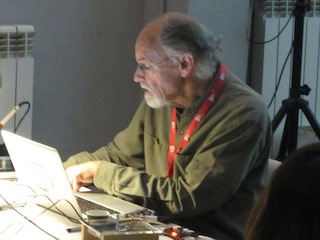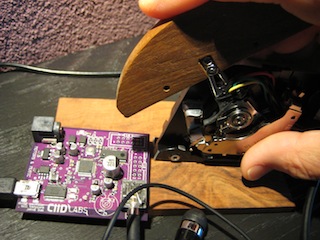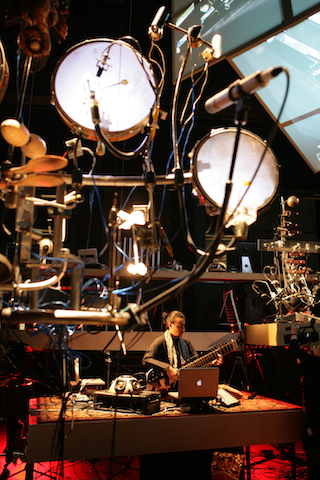13th International Conference on
New Interfaces for
Musical Expression
May 27-30, 2013 | Daejeon + Seoul, Korea Republic

program > keynote speakers
Bill Verplank
 Bill Verplank is an interaction designer, human-factors engineer and visiting scholar at Stanford University. He studied mechanical engineering and product design at Stanford (1960-1965) and returned there to teach "visual thinking" with Robert McKim (1971-1974). His PhD (1965-1977) is from MIT in man-machine systems with Thomas Sheridan, applying information and control theory to measuring human-operator work-load in manual control tasks. As a graduate student he won MIT's top teaching award, the Goodwin Medal and built kinetic sculpture at the Center for Advanced Visual Studies.
Bill Verplank is an interaction designer, human-factors engineer and visiting scholar at Stanford University. He studied mechanical engineering and product design at Stanford (1960-1965) and returned there to teach "visual thinking" with Robert McKim (1971-1974). His PhD (1965-1977) is from MIT in man-machine systems with Thomas Sheridan, applying information and control theory to measuring human-operator work-load in manual control tasks. As a graduate student he won MIT's top teaching award, the Goodwin Medal and built kinetic sculpture at the Center for Advanced Visual Studies.At Xerox (1978-1986) he participated in testing and refining the Xerox Star graphical user interface. For seven years, he taught "Graphical User Interface Design", "Graphic Invention for User Interfaces" and "Scenarios for Observation and Invention" as tutorials at the ACM SIGCHI conference and participated in developing the ACM SIGCHI Curriculum recommendations.
 From 1986-1992, he worked as a design consultant with Bill Moggridge at IDTwo and IDEO to bring graphical user-interfaces into the product design world; he started calling it "interaction design" instead of "user-interface design".
From 1986-1992, he worked as a design consultant with Bill Moggridge at IDTwo and IDEO to bring graphical user-interfaces into the product design world; he started calling it "interaction design" instead of "user-interface design".At Interval Research (1992-2000), he directed research and design for collaboration, tangibility and music. At Stanford, during that time, he worked with Terry Winograd to establish a studio course on Human-Computer Interaction Design which he taught for five years.
Since 2000, he has been a part-time lecturer at CCRMA, the Center for Computer Research in Music and Acoustics, at Stanford, teaching a course on designing input devices. He also served on the Steering Committee for the Interaction Design Institute Ivrea (2000-2005).
- Title: Motors and Music
Ajay Kapur
 Ajay's work revolves around one question: "How do you make a computer improvise with a human?" Using the rules set forth by Indian classical tradition, Ajay has been driven to build new interfaces for musical expression through extending the Indian classical Tabla, Dholak, & Sitar, with added microchips and embedded sensor systems, while designing custom robotic musical instruments. He now leads a team of artists and engineers exploring the intersection of music, composition, storytelling, science and technology in the KarmetiK Machine Orchestra.
Ajay's work revolves around one question: "How do you make a computer improvise with a human?" Using the rules set forth by Indian classical tradition, Ajay has been driven to build new interfaces for musical expression through extending the Indian classical Tabla, Dholak, & Sitar, with added microchips and embedded sensor systems, while designing custom robotic musical instruments. He now leads a team of artists and engineers exploring the intersection of music, composition, storytelling, science and technology in the KarmetiK Machine Orchestra.Ajay Kapur is currently the Director of the Music Technology: Interaction Intelligence and Design (MTIID) program at the California Institute of the Arts, as well as the Associate Dean for Research and Development in Digital Arts. He is also a Senior Lecturer of Sonic Arts Engineering at the New Zealand School of Music at Victoria University of Wellington. He received an Interdisciplinary Ph.D. in 2007 from University of Victoria combining computer science, electrical engineering, mechanical engineering, music and psychology with a focus on intelligent music systems and media technology. Ajay graduated with a Bachelor of Science in Engineering and Computer Science from Princeton University in 2002. He has been educated by music technology leaders including Dr. Perry R. Cook, combined with mentorship from robotic musical instrument sculptors Eric Singer and the world famous Trimpin. A musician at heart trained on drumset, tabla, sitar and other percussion instruments from around the world, Ajay strives to push the technological barrier in order to explore new sounds, rhythms and melodies.
Kapur has published over 80 technical papers and presented lectures across the world on music technology, human computer interface for artists, robotics for making sound, and modern digital orchestras. His book “Digitizing North Indian Music”, discusses how sensors, machine learning and robotics are used to extend and preserve traditional techniques of Indian Classical music.

